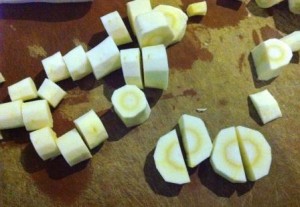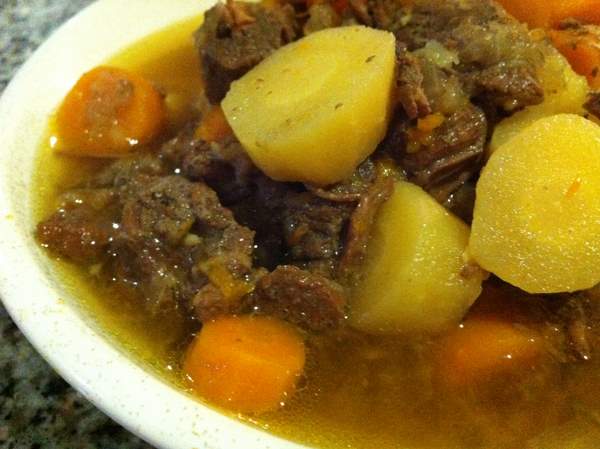This Primal/Paleo Beef Stew recipe has become one of my favorites, and I make it at least once a week. It requires a pressure cooker, so if you don’t have one, I recommend the Instant Pot Multifunction Pressure Cooker,  which is one of the newer electric safety countertop pressure cookers. It is nothing like the old pressure cooker that your grandmother (or great-grandmother!) fretted over because she was afraid it would explode. It has a tight fitting lid with a safety lock so that the lid can’t be removed until the pressure is entirely released, and I use it several times a week. A big bonus is that you can use it all summer long without heating up your entire house, since the heat is retained in the interior rather than being released into the air as steam. It is well worth the price, which was under $100 at the time I was writing this. You can also use a stovetop pressure cooker if you like (Please note that it is possible to cook this stew without using a pressure cooker; details at the end of the article). Total cooking time with a pressure cooker is about an hour (mostly hands-off). Back to the recipe:
which is one of the newer electric safety countertop pressure cookers. It is nothing like the old pressure cooker that your grandmother (or great-grandmother!) fretted over because she was afraid it would explode. It has a tight fitting lid with a safety lock so that the lid can’t be removed until the pressure is entirely released, and I use it several times a week. A big bonus is that you can use it all summer long without heating up your entire house, since the heat is retained in the interior rather than being released into the air as steam. It is well worth the price, which was under $100 at the time I was writing this. You can also use a stovetop pressure cooker if you like (Please note that it is possible to cook this stew without using a pressure cooker; details at the end of the article). Total cooking time with a pressure cooker is about an hour (mostly hands-off). Back to the recipe:
Primal Beef Stew
I developed this recipe on my own, and I can honestly say that I’ve never made a bad batch. There are several options for changing it up, so I will lay out my favorite version, and then mention some of the different ways you can customize the recipe. I specify amounts for each of the ingredients listed, but know in advance that most of these things can be adjusted to taste very easily.
Ingredients:
- Beef stew meat (2 or 3 pounds–grass fed stew beef is the most healthy, if you can afford it)
- 1 large onion, chopped
- 6 or 8 cloves of garlic
- 2 teaspoons table salt
- 1 teaspoon ground black pepper
- 1 cup red wine (or chicken broth or beef stock or water or Guinness beer)
- 1 to 2 pounds of carrots, peeled and chopped into ¾ inch slices/discs
- 2 or 3 bay leaves (optional)
And the recipe? Add the first seven ingredients to the pressure cooker and stir. The size of the carrots is not too important, and I actually prefer a mix of sizes. The pressure cooker will cook them well, but larger chunks will retain a bit of firmness, while smaller pieces may be quite soft at the end. Using beef stock or water or chicken broth as the liquid will give your stew a more traditional flavor, while red wine will give it a sort of beef burgundy richness. I have lately been using Guinness beer, and I think it makes a great alternative. After stirring, tuck the bay leaves down into the meat (if using). Put the lid on and start the pressure cooker on high. Set the timer for 40 minutes. If you are using a stovetop pressure cooker, start timing after it reaches pressure.
Once the first 40 minutes is up, carefully release the pressure (being careful not to burn yourself with hot steam—I use a wooden spoon handle to do this). When the steam is released and the safety latch opens, take the lid off and add the parsnips. Stir until mixed, breaking up any beef chunks that have stuck together. Place the lid on and cook on high for 9 or 10 more minutes. At the end of the cooking time, you can either let the pressure reduce on its own, or you can release the steam if you want to serve it quickly. Taste the stew and adjust the salt and pepper or other seasonings if necessary.
That’s it! You’ve just made some delicious and totally paleo/primal friendly beef stew with about 10 minutes of actual work (chopping and stirring), and less than an hour of cooking time.
Now for the ways you can customize:
I prefer a thick stew without too much liquid (you MUST use some liquid in a pressure cooker, or the food will burn, by the way), so if you prefer a more soupy or brothy stew, add another cup or so of liquid (but be aware that whatever liquid you add will not escape as steam, since it is sealed tightly, and the meat and vegetables will release some liquid as they cook, so the finished stew will look more liquid-y than what you see in the pot at the beginning).
I specify parsnips because I love them, and think they give a great flavor to the stew. If you’ve never had them, they’re kind of like a super-carrot, or a very strongly flavored carrot that is a bit perfume-y. They look like a carrot, but they’re white instead of orange. If you don’t like parsnips , or if you can’t find them (it’s harder to find them during the summer—here in Austin, Whole Foods doesn’t have them year-round, but Central Market does), you can substitute either rutabagas or turnips with excellent results; just cut them into ½ to ¾ inch dice and add them during the last 10 minutes in place of the parsnips. The reason for the divided cooking time is because the vegetables that go in at the end are softer, and if you cooked them for 40 minutes in a pressure cooker, they would completely fall apart into mush, whereas the carrots are much more firm, so they can take a longer cooking without dissolving. Turnips and rutabagas are a bit firmer than parsnips, but they should still be entirely cooked in the allotted 10 minutes. You could also add cauliflower (I have done it before when I didn’t have anything else on hand), but cauliflower is quite delicate, and if you cook it for longer than 5 minutes in a pressure cooker, it will dissolve, so just shorten the cooking time. The meat will be entirely cooked during the first 40 minutes, so the last 5 or 10 minutes is not even necessary. If you want just a beef and carrot stew, simply stop the cooking at 40 minutes and you’re done!
One last tip: the parsnips tend to start becoming discolored after they are peeled and chopped, so I usually wait until the first 40 minutes is up and then peel and chop them quickly. Parsnips are also quite variable in size, unlike most carrots. A parsnip might be an inch and a half thick at the top, only to taper quickly to a quarter-inch point. With thick parsnips, rather than cutting them into discs, I cut the thicker part off and cut it in half before cutting it into half moonshapes, and then cut the thinner part into discs.
Without a pressure cooker: if I were going to spend all day cooking beef stew, I would not follow this recipe. I would first brown the meat in small batches on all sides to develop some flavor and fond in the pot, and then I would simmer the ingredients for two hours or longer, long enough to give the collagen and connective tissue a chance to dissolve (stew meat is usually a mix of different cuts, and it usually includes a fair amount of connective tissue). The recipe above takes several shortcuts in order to make it an easy meal to make on weeknights. If you have all day, you can follow the steps above, but brown the meat in batches, then add your wine or broth and scrape the browned bits off the bottom of the pan (this will add flavor to the broth), add the ingredients as described in the first cooking period above (onions, garlic, beef, carrots, liquid (wine or broth or water), bay leaves, salt, pepper) and place the lid on the pot. Then place it in an oven that is set at 325 degrees F for two hours or longer. Add the parsnips or other ingredients and put it back in the over for another 30 minutes.



I just tossed all of these ingredients in the crock pot, put it on low, and went to work. One good stir in the morning and one in the evening and it is tasty.
I also add some thyme and sage. I refrain from salt until the very end. If I use stock I add a little red wine vinegar to make the flavor a bit more complex.
I will have to try it in the pressure cooker soon. Thank you for this recipe!